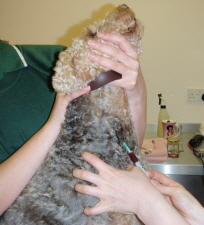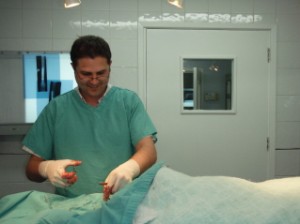Cushings Disease
Cushings disease is one of the most common hormonal disorders of dogs. It is caused by too much natural steroid in the body. It can be difficult to diagnose but is easily treated with tablets and occasionally surgery. It is very rare in cats.
- What is Cushings Disease?
- What causes Cushings Disease?
- What are the symptoms of Cushings Disease?
- Diagnosing Cushings Disease
- Treating Cushings Disease
- Potential Complications
- Prognosis
- Cushings Disease in Cats
What is Cushings Disease?
- Cushings disease or to give it its proper medical name ‘Hyperadrenocorticism’ is caused by the body producing too much natural steroid (cortisol) or if the animal has been prescribed large or long term doses of steroids for other medical conditions
- In normal doses, natural steroids are vital for good health, but in large doses they have detrimental effects on all the body systems.
- Cushings disease can be difficult to diagnose but it is relatively easy to treat. It is generally a life long condition.
What causes Cushings Disease?
- Cushings disease is caused by an over production of the body’s natural steroid hormone Cortisol. This over production is caused by tumours, of which there are 2 kinds;
- Pituitary Tumours – the pituitary gland is a small gland in the brain which is involved in the production of several hormones in the body. These tumours are very small, generally less than 10mm, and are often microscopic. They are also benign, so will do not spread or cause other problems. They account for about 80% of Cushings cases.
- Adrenal Tumours – there are 2 adrenal glands in the body, one on top of each kidney. They produce several of the body’s hormones, including the steroid hormones. About half of these tumours are benign and half are malignant ( so they can spread) They are more common in large breed dogs, but account for only 20% of Cushings cases.
- It can also be caused by giving steroids in drug form over a period of time, so called ‘Iatragenic Cushings Disease’. This is an unusual side effect of steroid dosage, and normally occurs only when the drugs have been given over a long period of time or in large doses.
What are the symptoms of Cushings disease?
There are many different clinical signs of Cushings disease, and an animal generally has to have several together before a vet will suspect the disease. Clinical signs include:
- Abdominal enlargement – a dogs belly will often become bigger or ‘saggy’ with Cushings disease. The high levels of steroid cause the abdominal muscles to weaken and stretch. There is also a redistribution of fat to the abdomen and the liver often enlarges.
- Drinking and urinating more – this is present in most cases and can involve the animal drinking and urinating huge amounts.
- A normal animal will drink about 50ml water per kilo body weight per day. If you are at all concerned about your pets water intake, measure it over a few days and take the figure to your vet, along with a urine sample.
- Increased appetite – steroids will make your pet feel much more hungry It is well known that animals,as well as people, will often gain weight when on steroids.
- Lethargy or weakness – steroids have detrimental effects on the muscle, causing them to weaken. This is also the case with the muscles of the legs, they will often waste away and animals are noticeably less active or weaker. For example, dogs may no longer be able to jump in the car, climb the stairs as easily or cock their legs.
- Skin changes – high levels of steroids also weaken the skin; it can become thinner, the veins in the skin are often more visible, especially on the abdomen. It can become flaky and dry and often it is very slow to heal from cuts and abrasions. Often there is hair loss (alopecia), this can be in a very obvious symmetrical pattern over the animals sides and flanks.
- These symptoms can often come on slowly over several months and therefore be difficult to spot. They are often mistaken for general aging changes.
- Cushings disease generally occurs in middle-aged to older animals.
- There are no particular breed predilictions for the disease, but pituitary based tumours tend to be more common in small breeds of dog, and adrenal tumours are more common in larger breeds.
- There is no particular sex predisposition either, but adrenal tumours are more common in female dogs.
Diagnosing Cushings disease
It is important that before any blood tests are taken, the animal is showing significant clinical signs of Cushings disease. It can be difficult to diagnose and if the signs are only subtle, the results are often border-line.
General tests
- Full Blood Profile – the first test to perform is a general health profile blood test. This will look at all aspects of your pets health. In Cushings disease, there are often signs of liver stress, high levels of fats in the bloods, high cholesterol and high blood glucose.
- Urine tests – again this is a general health screening test, but is very important. Animals with Cushings will have very dilute urine. They can also have sugar in the urine, which also occurs in diabetes, and urinary infections are common.
Specific Tests
- ACTH Stimulation test -this is the most common of the specific tests for Cushings Disease, it is used in the diagnosis and also the monitoring of the condition.
- In this test, the animal is injected with ACTH (adrenocorticotropic hormone). This hormone occurs natually in the body and stimulates it to produce cortisol.
- In normal animals the cortisol levels will rise in response to the ACTH but only moderately. In animals with Cushings disease the body is hypersensitive to the hormone and the levels of cortisol will rise very high.
- It is a quick and easy test to perform. Your vet will take a blood test, then inject your pet with ACTH. A second blood sample is taken about 1 hour later.
- This is a good test, and the first a vet will generally pick to diagnose Cushings disease. It is also the test used to monitor your dogs condition.
- However, no test is 100% accurate and not all Cushingoid dogs will be picked up. Also, it cannot distinguish between pituitary and adrenal Cushings.
- Low dose dexamethosone supression tes
- This test is more reliable than an ACTH stimulation test at diagnosing Cushings disease, as it will pick up more cases, but it takes 8 hours to complete and cannot be used to monitor the disease.
- Dexamethosone (Dex) is a synthetic steroid, similar to the natural steroid cortisol. In normal dogs, after being injected with Dex, the levels of cortisol will drop as the body realises it has more steroid than it needs. With Cushings, the natural steroid levels will remain very high despite the Dex.
- Several blood tests are taken from the dog, normally before the Dex is injected, then 3 and 8 hours later. The level of cortisol is measure in each test, and the result will determine the diagnosis of Cushings.
- High dose dexamethosone supression test.
- This is similar to the low dose Dex test, but much higher doses of Dex are used.
- The main use of this test is to to determine whether the animal has a adrenal or pituitary tumour causing the problem.
- However, it will still miss about 20-30% of pituitary tumours.
- Endogenous ACTH concentration
- This test measures the levels of natural ACTH in the animals system. It is only really used to distinguish between pituitary and adrenal tumours.
- Animals with pituitary tumours tend to have very high levels of ACTH in their system, whereas in animals with an adrenal tumour, the levels tend to be low.

Blood tests are the mainstay of diagnosis in Cushings disease.
- Urine corticoid:creatinine ratio
- Cortisol is excreted by the body in the urine. The levels of cortisol can be measured in the urine, and this can give a good indication if they are excessive or not.
- It is important to use a sample from the first urination of the morning, and also to collect that at home. Being in the vets can be stressful for an animal, which will cause the cortisol levels to rise and may give a false results.
- This test cannot tell the difference between pituitary and adrenal tumours.
- It is also not useful in monitoring the disease, just its diagnosis.
Imaging
- Both radiography (x-rays) and ultrasound scans of an animal are very helpful in the diagnosis of cushings disease.
- Radiography (X-rays)
- The most useful finding in an animal with Cushings disease when they are x-rayed is to find enlarged or calcified adrenal glands. Both of these findings will indicate the disease is caused by an adrenal tumour.
- However, it is unusual to see the adrenal glands on an x-ray, but they will show other signs which will point towards a diagnosis of Cushings disease
- The most consistant finding on xrays is an enlarged liver, large deposits of abdominal fat, and sometimes bladder stones.
- Ultrasound
- It is not easy to see a dogs adrenal glands using ultrasound, as they are generally very small and buried in fat. Usually only vets very experienced with ultrasounding are able to find them.
- However, if the glands can be seen, it can give an indication as to whether the disease is due to a pituitary or adrenal tumour.
- In pituitary dependent Cushings disease, the adrenal glands may be enlarged, but they will be symmetrical and retain their normal shape.
- In adrenal dependent Cushings disease, one gland is often significantly larger than the other, and if the tumour is malignant, it can be possible to see evidence of the tumour spreading.
Treating Cushings Disease
Iatragenic Cushings disease
- This usually involves simply withdrawing the steroid treatment that cause the animal to become cushingoid.
- It is important to slowly reduce the levels of steroid in the system, as stopping them suddenly can cause other problems.
Medication
Vetoryl
- The main treatment of Cushings disease is daily tablets of a medicine called ‘Vetoryl’
- The active ingredient is called ‘Trilostane’, it reduces the production of cortisol from the adrenal glands and ensures it remains in normal levels
- It is a life long medication, but is very effective and very safe.
- Generally a single tablet needs to be given once daily.
- The response to the treatment needs to be monitored. you vet will take blood tests;
- 10 days after starting the medication
- 4 weeks after starting the medication
- and every 3 months after that.
- The blood test of choice for monitoring the treatment is the ACTH Stimulation test, which has been discussed above.
- The ideal time for running this test is 4-6 hours after the tablet has been given. So, do let your vet know when your pet usually has their tablet.
- You can also monitor the response at home, if the tablets are working, the amount your pet drinks should fall dramatically.
- The side effects from Vetoryl are unusual but can include, vomiting, diarrhoea, lethargy and anorexia. If you see any of these, or are at all concerned, you should contact your vet.
Vetoryl tablets are the only licensed treatment for Cushings Disease.
Lysodren
- Lysodren used to be the drug of choice to treat Cushings, but now Vetoryl is licensed it is used more commonly instead.
- The active ingredient is Mitotane.
- It is ‘cytotoxic’ to the cells if the adrenal gland,. This means it destroys the cells which over-produce the cortisol.
- There is an initial ‘Induction’ course of the drug where it is given on a daily basis, until the signs of Cushings ie drinking more, disappear. This can taken between three to ten days.
- Then the animal is put on a ‘maintenance’ dose. At this stage the drug is given only once every seven to ten days.
- Lysodren needs to be handled very carefully, gloves must be worn when you handle the tablets.
- It is now difficult to obtain Lysodren as Vetoryl works so well. However, if an animal doesn’t respond to Vetoryl, is is a valid alternative.
Surgery
- In adrenal dependent cushings disease, it can be possible to remove the enlarged and overactive adrenal gland, and cure the dog of cushings.
- However, it is a complicated surgery, and is generally only carried out by specialists
- Prior to the surgey taking place, the dog would undergo xrays and ultrasound scans in order for the vets to see where the tumour is, and how large it is.
- If the tumour is malignant, it may well have already spread, and therefore surgery would be of questionable value.
- It is important to stabilse the animal first with medical therapy, as untreated Cushingoid dogs are poor surgical candidates

Surgery is a treatment option for dogs with an adrenal tumour. However, if the tumour is maligant, it may have already spread.
Complications
- Complications of treatment for Cushingoid dogs are rare.
- The most common are side effects from the treatment, such as vomiting and diarrhoea. However, these are unusual and generally settle with time.
- It is possible with the treatment to give the animal ‘Addisons Disease’ which is the opposite of Cushings. This will be picked up on the blood tests, or clinical signs. To learn more about Addisons disease, click here.
Prognosis
- The prognosis for Cushingoid dogs is very good, provided the treatment is kept up.
- Animals can lead full and active lives.
Cushings Disease in Cats
- Cushings disease in cats is uncommon.
- The major abnormality seen is that affected cats will drink very large amounts.
- They are often first diagnosed as diabetics, as they have very high blood sugar levels and sugar in the urine, but they will not improve when given insulin.
- They can also present with urine infections ( cystitis), or very fragile skin which tears easily.
- It is diagnosed by blood tests, both general blood profiles and the ACTH stimulation test, or the Low Dose Dexamethosone test. (see above)
- It can be very difficult to treat cats with Cushings disease, as they do not respond well to either Vetoryl or Lysodren.
- Surgery can be performed if there is a tumour on the adrenal gland.
- The prognosis for long term survival or control is not good.

Cushings Disease is very rare in cats, but when it occurs it usually carries a very poor prognosis
Please note, this is an advice only website. If you have any specific queries or concerns about your pet, please contact your vet.